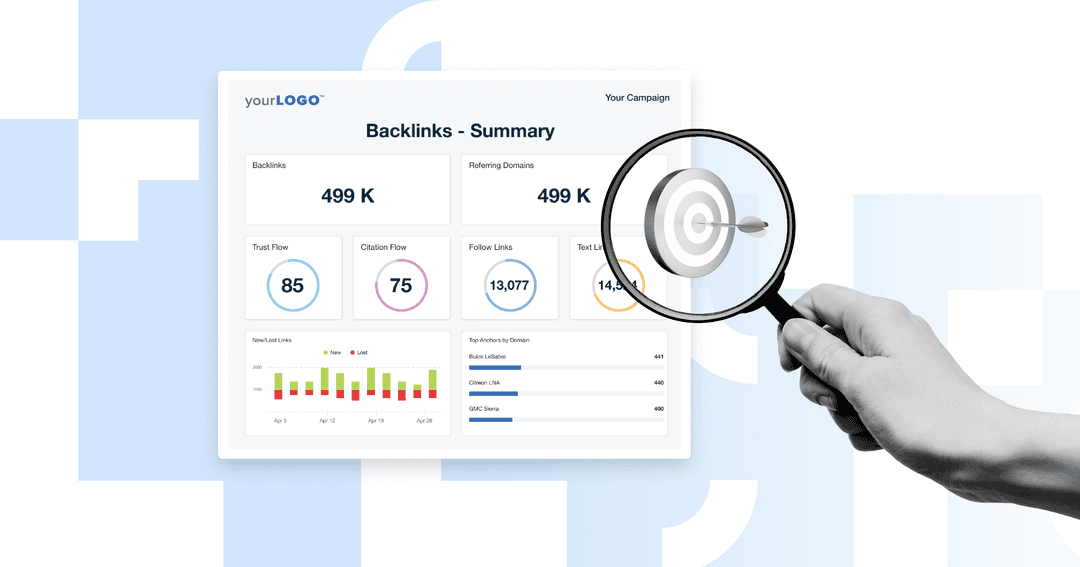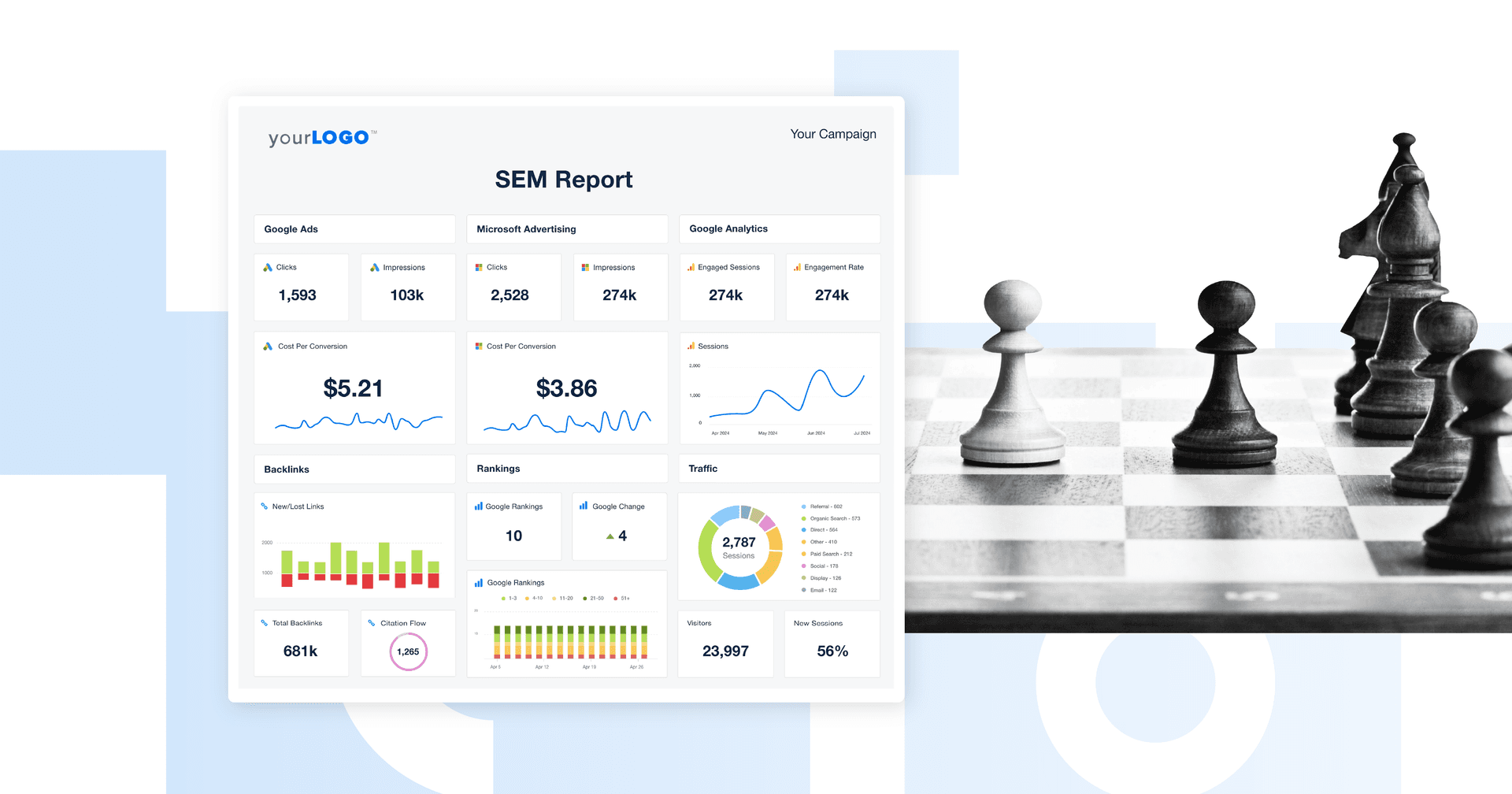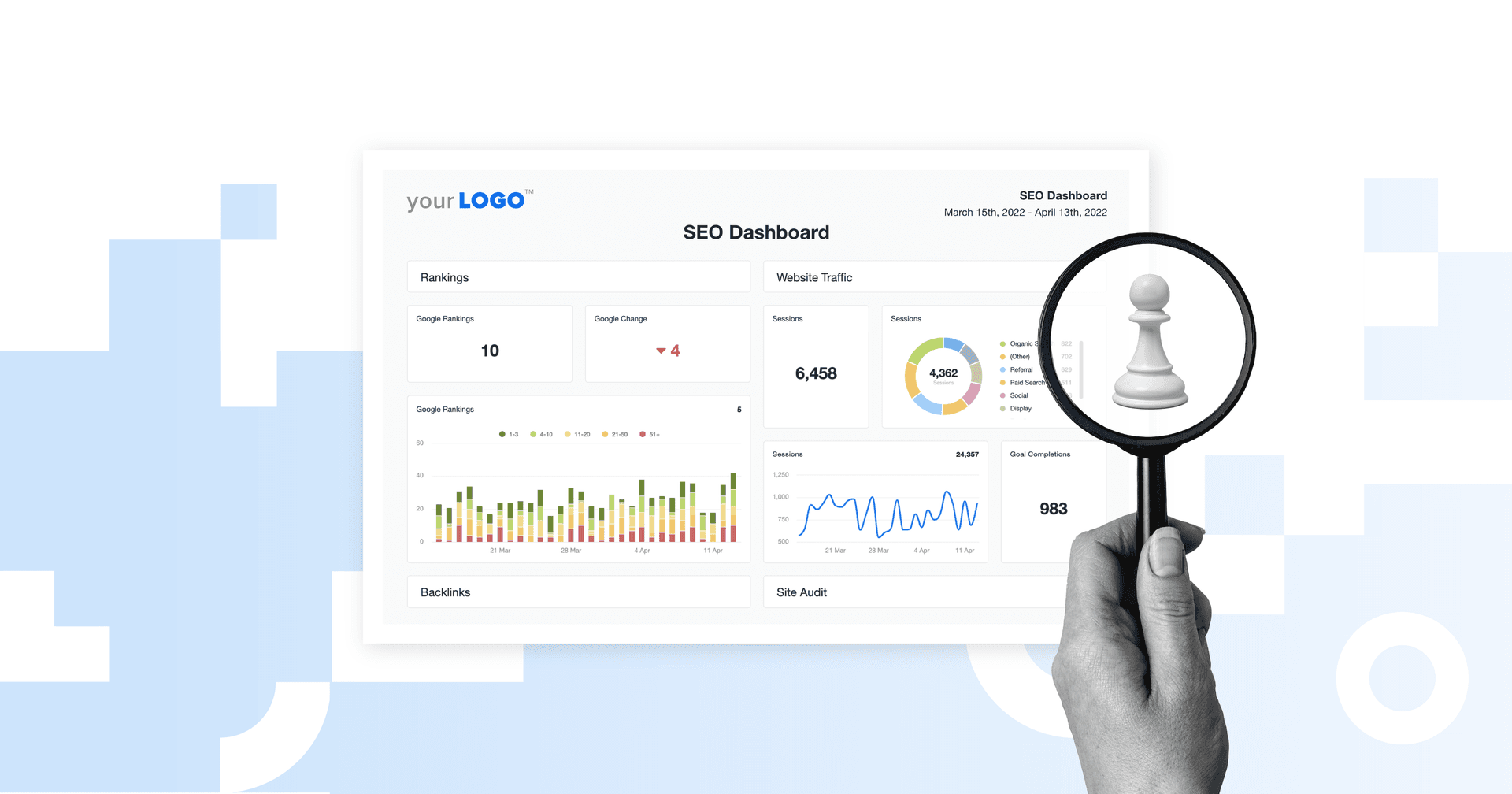Table of Contents
Table of Contents
- What Is Competitor Backlink Analysis?
- Why a Backlink Analysis Is Hyper-Important
- Backlink Analysis Tools You Will Need
- How To Do a Competitor Backlink Analysis in 3 Easy Steps
- Don’t Let the Competitor Backlink Gap Get Too Big
- How to Track Backlinks & Report Progress to Clients
- Invest in a Robust System to Monitor and Optimize Backlink Efforts
7,000+ agencies have ditched manual reports. You can too.
Free 14-Day TrialQUICK SUMMARY:
Competitive backlink analysis is the process of examining competitor backlinks to uncover valuable link-building opportunities. It's used to identify high-authority referring domains, create successful link-building strategies, and enhance SEO performance. This article explores why competitive backlink analysis matters, tips for prioritizing outreach efforts, and how automation tools streamline the entire process–leveraging tips from our 7,000+ strong community of agency leaders.
Ever wonder how client competitors keep landing high-authority backlinks?
It’s not by chance—it’s a strategic process. The good news? With the right approach, you can analyze, replicate, and even outperform their link-building efforts.
Competitor backlink analysis is one of the most effective ways to reverse-engineer successful SEO strategies. Instead of starting from scratch, it identifies where competitors are earning links, which domains hold the most value, and how to secure similar (or better) opportunities for your clients.
Effective backlink analysis goes beyond collecting a list of links, though. It’s about understanding why those links exist, which ones drive results, and how to leverage automation to streamline the process.
Ready to build more competitive link profiles for your clients and boost their search rankings? This article explores the ins and outs of competitive backlink analysis, including a step-by-step process and a curated list of tools that simplify the process.
What Is Competitor Backlink Analysis?
A competitor backlink analysis is the process of identifying and assessing the links pointing to competing websites.
It provides insight into where competitors earn backlinks, which ones contribute most to their rankings, and how similar or better links can be secured.
At its core, a competitor backlink analysis answers three key questions:
Who is linking to competitor websites?
Which backlinks are driving the most SEO value?
How should similar or stronger backlinks be acquired?
This thorough assessment helps agencies develop a more strategic, data-driven approach to link-building. Over time, it ensures SEO efforts are focused on high-impact opportunities that improve rankings, build authority, and drive organic traffic.
Why a Backlink Analysis Is Hyper-Important
Websites with high-quality backlinks hold more authority and credibility in the eyes of search engines. That’s why agencies that actively track and optimize backlink profiles outperform those that don’t.
So, why exactly is competitor backlink analysis important? Here’s precisely why it should be a core part of any client’s SEO strategy.
1. It Uncovers Competitor Strategies (And Gaps To Capitalize On)
A competitor’s backlink profile tells a story—where they’re earning links, what type of content attracts them, and which relationships they’ve built.
By exploring competitor backlinks, you’ll:
Spot Gaps in Client Backlink Profiles: If a website links to a competitor, there’s a good chance they’ll link to your client, too—if you give them a compelling reason. This is an opportunity to reach out with valuable content, a guest post pitch, or a resource that aligns with audience interests.
Benchmark Link Quality and Authority: Not all backlinks carry the same weight. Analyzing competitor links helps prioritize high-authority domains while avoiding low-quality sources that could harm SEO.
Refine Your Client’s Link-Building Strategy: Instead of guessing where to focus link-building efforts, use competitor insights to target the most impactful backlinks. This ensures a more strategic approach, saving time and improving results.
By analyzing competitor link profiles, agencies will build stronger link-building strategies that drive real, sustainable results.
2. It Directly Impacts Search Rankings
Search engines like Google use backlinks as a major ranking factor. If a website has high-quality backlinks from authoritative sources, it's seen as more trustworthy and relevant. Over time, it leads to better search engine results.
Backlinks remain the best indicator to Google and other search engines that a webpage is considered important by internet users. Links can be compared to votes, only when it comes to backlinks votes are not equal. The more relevance and authority a website has, the more weight the vote gets.
Andy Hill, Managing Director, Distribute Digital
Here’s something to remember: If competitors gain high-quality backlinks faster than your client, they’ll likely outrank them in search results—even with content of the same quality. Frustrating, right?
While SEO and search algorithms aren’t fully within your control, competitor backlink tracking levels the playing field. It provides a clear view of where your client is excelling, where they’re falling behind, and which link-building opportunities will have the most significant impact.
3. It Justifies SEO Efforts to Clients
SEO often feels abstract to clients who don’t see immediate results, which makes it even more critical to demonstrate results.
One of the most measurable ways to do this is through backlink growth and authority metrics—key indicators of long-term search performance.
A well-executed backlink strategy leads to:
📈 Higher Rankings → When clients see their targeted keywords moving up in the Google SERPs, it validates your SEO efforts.
🔗 Better Domain Authority → By consistently investing in strategic link-building, clients benefit from higher Domain Authority (DA) and Trust Flow scores. These metrics indicate stronger website relevance, helping them compete with industry leaders.
💰 Stronger SEO ROI → When clients see a clear connection between link-building and organic traffic growth, they’ll be more inclined to invest in long-term SEO efforts—increasing retention for your agency.
SEO takes time; it’s just a fact. However, with the right approach, clients will see steady improvements and build more confidence in your agency’s services.
Backlink Analysis Tools You Will Need
To run an effective competitor backlink analysis and identify opportunities, you’ll need the right tools. Here’s a breakdown of our top picks, including free and paid options.
Free Backlink Analysis Tools
For agencies in the early stages of the digital agency lifecycle, free tools are a great starting point for basic backlink insights–here are a few worth considering.
Google Search Console
A tool like Google Search Console works well to identify your client’s top-performing keywords, pages, and locations. It also provides granular insights into impressions, click-through rates, and average search position.
That said, it doesn’t offer insights into competing domains, which is somewhat limiting as your roster grows. Still, it’s a staple for most agencies as it provides useful search insights and complements other SEO efforts.
Agency Tip: Use a customizable Google Search Console dashboard to access key insights and view them alongside related marketing data. That way, you’ll have a more holistic understanding of your client’s SEO performance.
Backlink Checker by Ahrefs (Free Version)
Ahrefs offers a free backlink checker tool, which provides a snapshot of a website’s top backlinks along with metrics like Domain Rating (DR) and URL Rating (UR).
While useful for quick insights, the free version limits the number of backlink queries and historical data. Most agencies will need to upgrade to the paid version for deeper competitor research.
SEO SpyGlass (by SEO PowerSuite)
SEO SpyGlass analyzes competitor backlinks, highlighting where they’re earning links and uncovering valuable outreach opportunities. It also evaluates backlink quality, filtering out low-authority sites that could negatively impact SEO.
However, the free version only shares insights for one competitor per project. To access advanced features (like analysis of an unlimited number of backlinks), users must subscribe to a paid option.
Paid Competitor Backlink Analysis Tools
For agencies serious about scaling their link-building strategy, paid tools provide access to larger backlink databases, competitive gap analysis, and historical trends.
Here are some top tools to streamline backlink analysis and track competitors with greater precision.
Ahrefs
Ahrefs is a leading SEO competitor analysis tool known for its extensive backlink database and in-depth competitor analysis features. It offers detailed insights into backlink profiles, Domain Rating, and link acquisition trends.
Additionally, it allows agencies to identify high-authority referring domains, and find content that attracts the most links. Their Standard package starts from $249/month, with an Advanced option priced at $449/month.
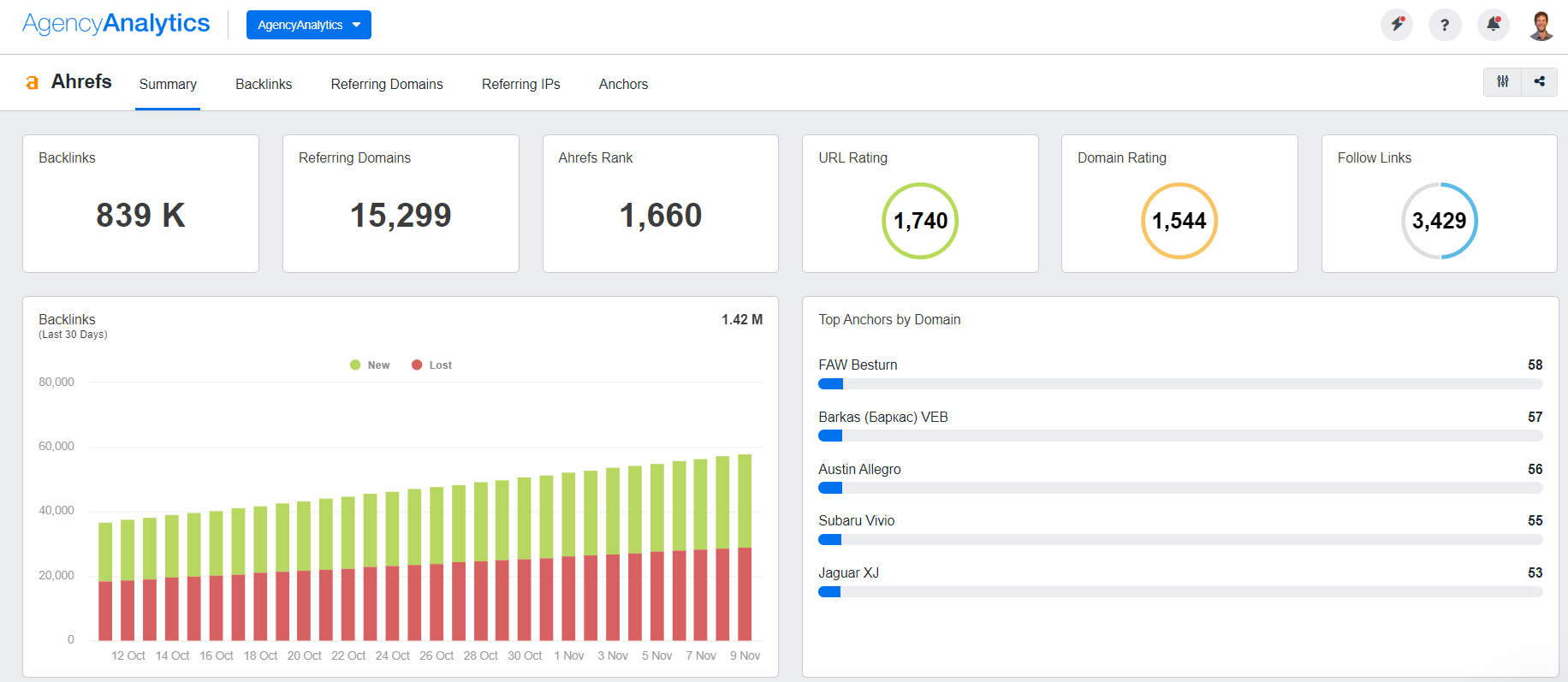
Monitoring Ahrefs backlink data like broken links, URL Rating, and referring domains? View these insights alongside metrics from 80+ platforms; try AgencyAnalytics, free for 14 days.
Semrush
Semrush is an all-in-one SEO platform that offers backlink analysis, keyword research, and competitive insights. Its extensive database delivers real-time updates on new and lost links, enabling agencies to monitor trends and adjust SEO strategies effectively.
Agencies will benefit from their Guru package, which starts at $249.95/month. For larger operations, their Business plan is priced at $499.95.
Using multiple SEO tools or marketing platforms? Stream Semrush data into a visual dashboard or report and customize it with metrics from other channels.
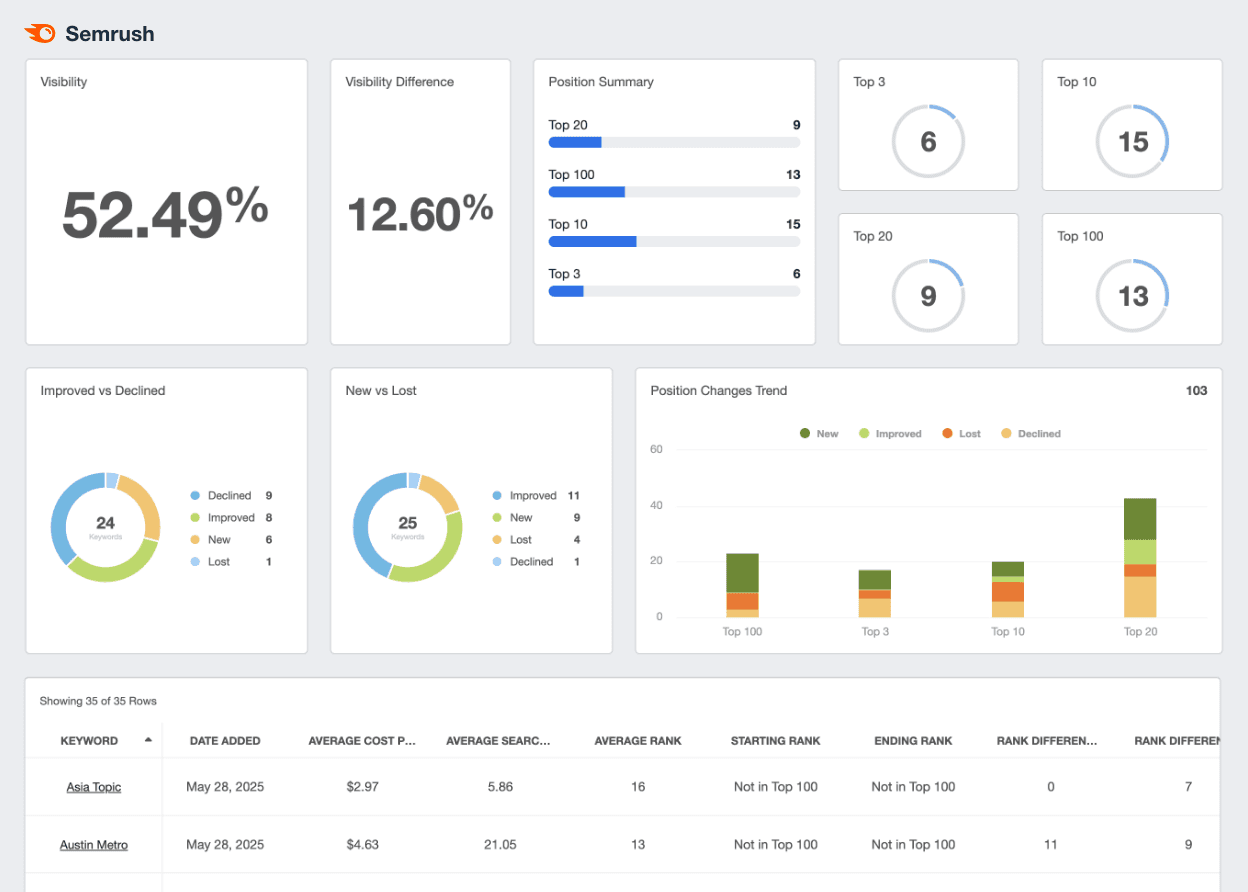
Moz
Moz is a comprehensive SEO tool offering backlink analysis, keyword research, and site audits. It’s best known for its Domain Authority (DA) and Page Authority (PA) metrics, which help assess the strength of competitor backlinks and overall site credibility.
Pricing starts at $179/month for a Medium plan. Advanced features are available in the Large plan, starting from $299/month.
For a more streamlined workflow, filter Moz data into a visual, simplified dashboard. That way, you’ll have backlink data alongside other key SEO metrics.
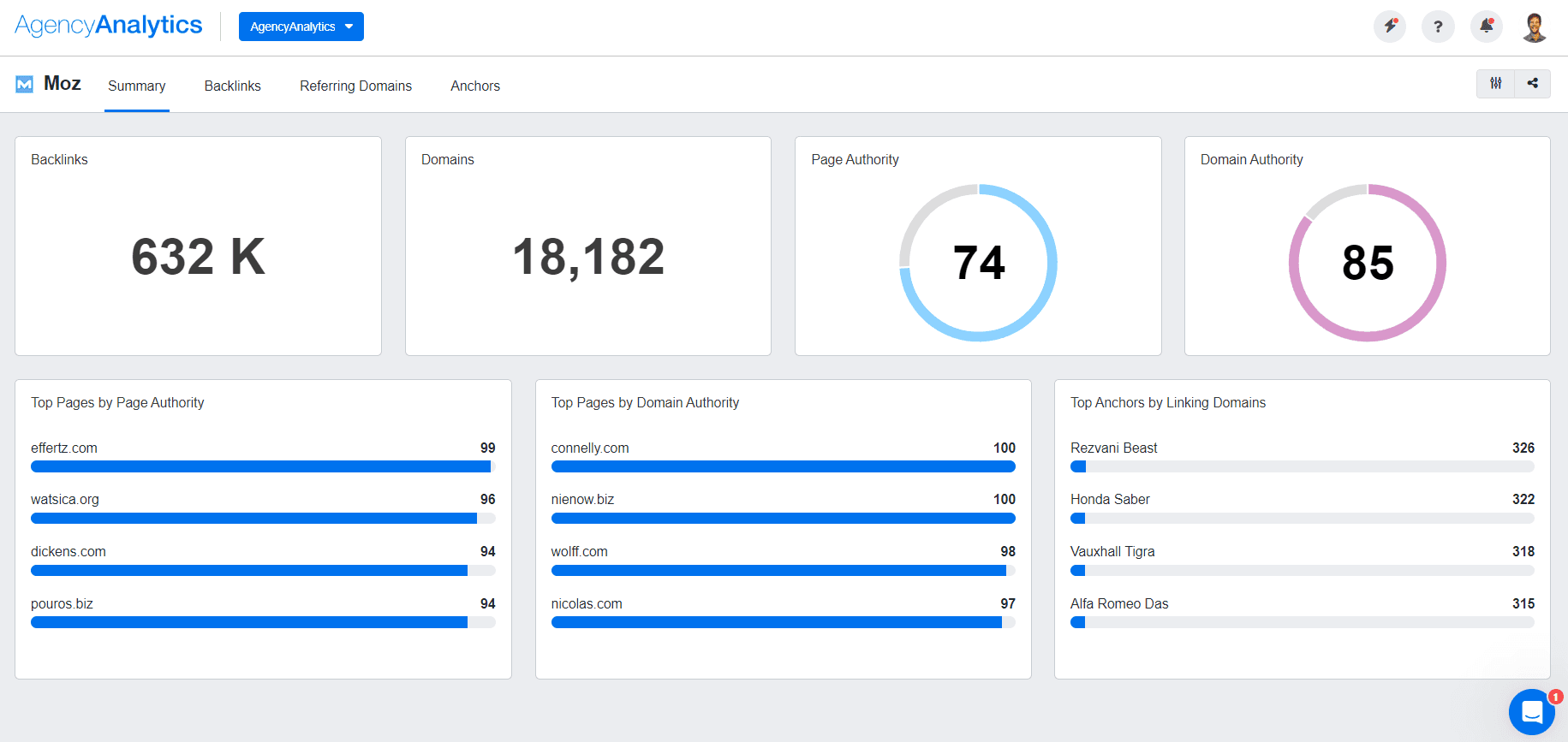
Majestic
Majestic specializes in backlink trust metrics, making it a strong choice for agencies focused on link quality over quantity. It provides unique scoring systems to assess domain strength and backlink credibility.
Pricing starts at $99/month for the Pro plan, while the Full API plan is available at $399/month for deeper data access.
Majestic seamlessly integrates with AgencyAnalytics, making it easy to monitor backlink trust scores and link quality within a unified reporting platform.
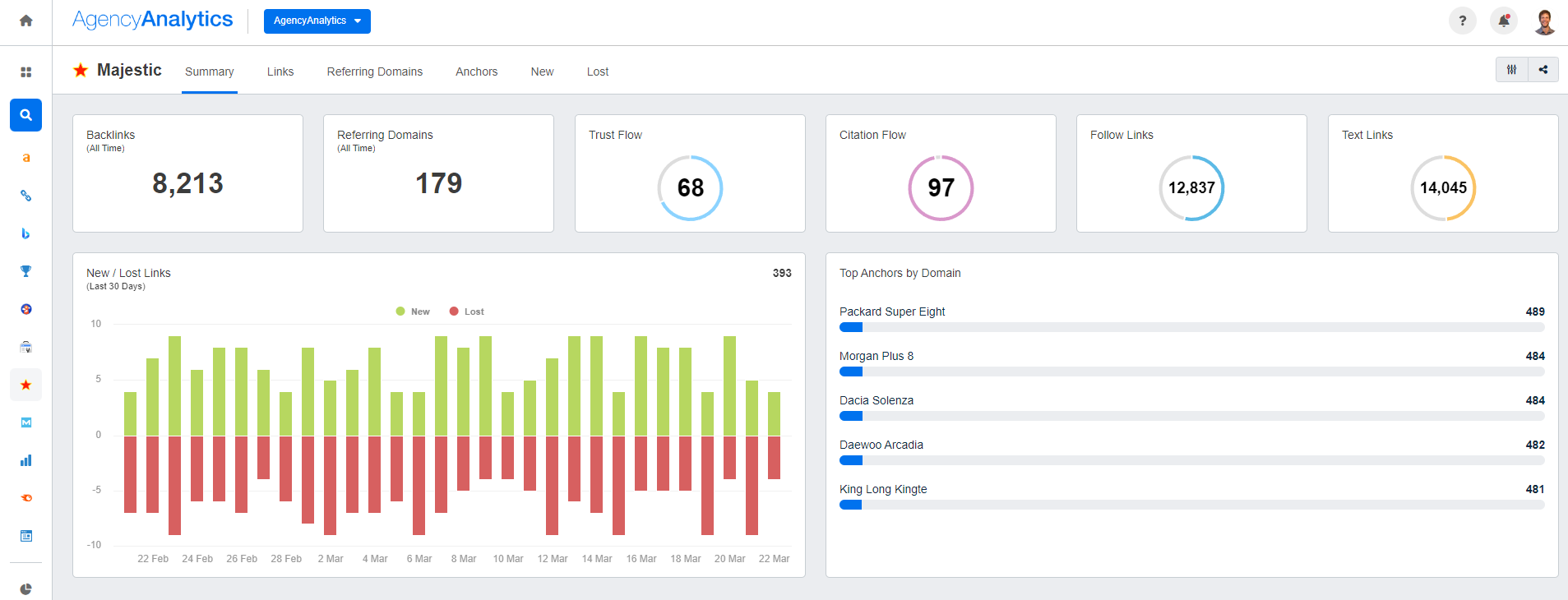
How To Do a Competitor Backlink Analysis in 3 Easy Steps
Now that you’ve got the right tools, it's time to put them to work. Here’s a three-step process to uncover and leverage competitor backlinks.
Step 1: Identify Your Client’s Top Organic Competitors
A strong backlink strategy starts with knowing who your client is really competing against in search results.
These aren’t always their direct competitors—they’re the websites ranking for the same target keywords. Here’s a strategic approach to uncovering this valuable information.
Step | How To Do It |
|---|---|
Leverage SEO Tools | Enter a primary keyword into a tool like Ahrefs, Semrush, or Moz and generate a list of top-ranking linking domains. This will reveal your client’s true SEO competitors (not just the ones on their immediate radar). |
Google Search Top Keywords | Perform a Google search for a primary keyword and note the top ten ranking domains. If specific sites appear frequently across different keyword variations, note them as key SEO competitors. |
Analyze Industry Directories & Blogs | Search for niche-specific directories, blogs, or resource pages using search queries like “[industry] best blogs” or “top [industry] directories.” Also, use Ahrefs or Semrush to find which sites link to multiple competitors. |
Understanding who’s linking to competitors—and why—sets the stage for finding high-value backlink opportunities. This will help your client compete and rank higher in search results.
Step 2: Find Common and Uncommon Backlinks
Once you’ve identified SEO competitors, the next step is to analyze where they’re getting backlinks from. To do this, look at:
Common Backlinks: These are websites that link to multiple competitors but not to your client. Since they already link to similar businesses, they’re low-hanging fruit. In other words, a well-crafted outreach pitch could secure a backlink with minimal effort.
Uncommon Backlinks: This term refers to backlinks that only one or very few competitors have. They're often earned through unique content, partnerships, or niche outreach efforts. Most often, these websites will also have high Domain Authority (DA) or Trust Flow (TF), which carry significant weight in search rankings.
By analyzing backlink types, you’ll identify easy wins, uncover competitor strategies, and refine outreach to focus on the most valuable opportunities.
Step 3: Sort Backlinks by "Tiers"
Backlinks aren’t built equally.
Some provide a significant boost in rankings, while others are useful for diversification (but carry less weight). To make the most of your client’s outreach efforts, categorize competitor backlinks into tiers based on their SEO impact.
Generally speaking: The higher the tier, the greater the authority, relevance, and ranking impact of the backlink. Here’s a quick breakdown for reference:
Tier 1: High-authority, niche-relevant backlinks that provide the strongest SEO impact.
Tier 2: Mid-tier backlinks that add credibility and strengthen your client’s backlink profile.
Tier 3: Lower-value links that offer diversity but shouldn’t be a primary focus.
For added context, let’s dive into the specifics of how to leverage these backlink tiers for optimal results.
Tier 1: High-Authority, Niche-Relevant Links
These are valuable backlinks from high-DA websites relevant to your client’s niche or industry. They typically include:
Links from industry-leading websites (e.g., niche-specific media outlets or authoritative blogs).
Mentions in government sites, educational institutions, or trusted directories.
Guest posts on high-traffic, relevant industry blogs.
Acquiring even one of these can make the world of a difference. Remember: A few high-authority, relevant backlinks are more valuable than dozens of low-quality ones.
Sometimes, it can take only one website to tip the balance of the scales and make Google sit up and pay attention. It has to be a very authoritative site, but nevertheless, it's not always about quantity.
Andy Robson, Agency Director, Squidgy
Tier 2: Mid-Level Authority Links
Tier 2 backlinks come from moderate-DA, authoritative websites that are still contextually relevant to your client’s industry. They offer valuable link diversity and support primary Tier 1 efforts.
These links strengthen your client’s overall link profile, improving relevance and trust without the intense competition of Tier 1 sources. Some examples include:
Links from smaller industry blogs, regional news sites, or community forums.
Mentions in niche directories or resource pages that may not have the highest authority but are relevant to your client’s content.
Guest contributions on up-and-coming industry blogs.
While Tier 2 backlinks may be easier to acquire than Tier 1, they still require thoughtful outreach and relationship-building to be truly effective.
Never rush something just to get it out the door. Focus on quality over quantity, both in terms of links and the output to get those. Publishers see thousands of requests a week. Therefore, you need to stand out. A rushed email or message will either be overlooked or disregarded.
Andy Robson, Agency Director, Squidgy
Tier 3: Easy-to-Get Links (But Still Valuable)
Tier 3 backlinks are from low-DA websites that may not directly relate to your client’s industry but still contribute to overall link volume.
While less impactful individually, Tier 3 links provide volume and diversification, which helps protect against algorithm fluctuations. They’re best used in conjunction with Tier 1 and Tier 2 links.
Diversity in backlinks is important. A balanced mix of follow and no-follow links–in addition to paid and organic links–is a smart practice! Backlinks build value. Value brings hiring ranking keywords. Highly ranking keywords bring traffic.
Christopher Bailey, Website Design and SEO, D2 Branding
More specifically, this tier includes:
Links from generic directories, blog comments, or social bookmarking sites (such as Yelp and Yellow Pages).
Mentions in local business listings or low-traffic blogs (e.g., Chamber of Commerce websites).
When using Tier 3 backlinks, focus on reputable sources and steer clear of low-quality sites that could hurt SEO rather than help it.
Don’t Let the Competitor Backlink Gap Get Too Big
Finding competitor backlinks is just the first step. The real challenge is keeping up with competitors who are constantly building new links.
The solution? Conduct a competitor backlink gap analysis—it's an ongoing exercise, not just a one-time project. To simplify the process, follow these actionable steps.
Step | How To Do It |
|---|---|
Monitor Competitor Link Growth | Use tools like Ahrefs or Semrush to track the number of new backlinks competitors gain each month. Identify trends and spikes in link acquisition. |
Set a Monthly Link Goal | Analyze competitors’ link velocity (i.e., how fast they’re gaining backlinks for specific keywords) and set a realistic goal to match or exceed their growth rate. |
Prioritize High-Value Links | Focus on acquiring Tier 1 and Tier 2 backlinks from authoritative sources instead of chasing large numbers of low-quality links. |
Leverage Competitor Link Sources | Use Majestic or Semrush to find domains that link to multiple competitors. Then, target these sites for outreach and guest post opportunities. |
Track Lost & Gained Backlinks | Regularly check for lost or broken backlinks. Reach out to site owners to reclaim valuable lost links and maintain a strong backlink profile. |
Consistently tracking competitor backlinks ensures a strong profile and prevents ranking declines. With the right approach, you’ll identify competitors, stay one step ahead, and create a more effective link-building campaign.
How to Track Backlinks & Report Progress to Clients
Building backlinks is one thing—showing clients the real impact is another.
Let’s be honest–most clients don’t understand SEO jargon like Domain Authority (DA), referring domains, or backlink velocity. Even so, they still need proof that their SEO efforts are working.
That said, clunky spreadsheets or screenshots from multiple platforms are just unsightly. Why not jazz things up and improve efficiency? A tool like AgencyAnalytics consolidates link-building data into one place, automatically pulling insights from 80+ platforms, including Semrush, Moz, Majestic, and Ahrefs.
It’s not difficult to set things up, either–here’s how to get started.
Connect Your Client’s Integrations To AgencyAnalytics
First, sign into your AgencyAnalytics account and head to “Integrations” in the left-hand menu.
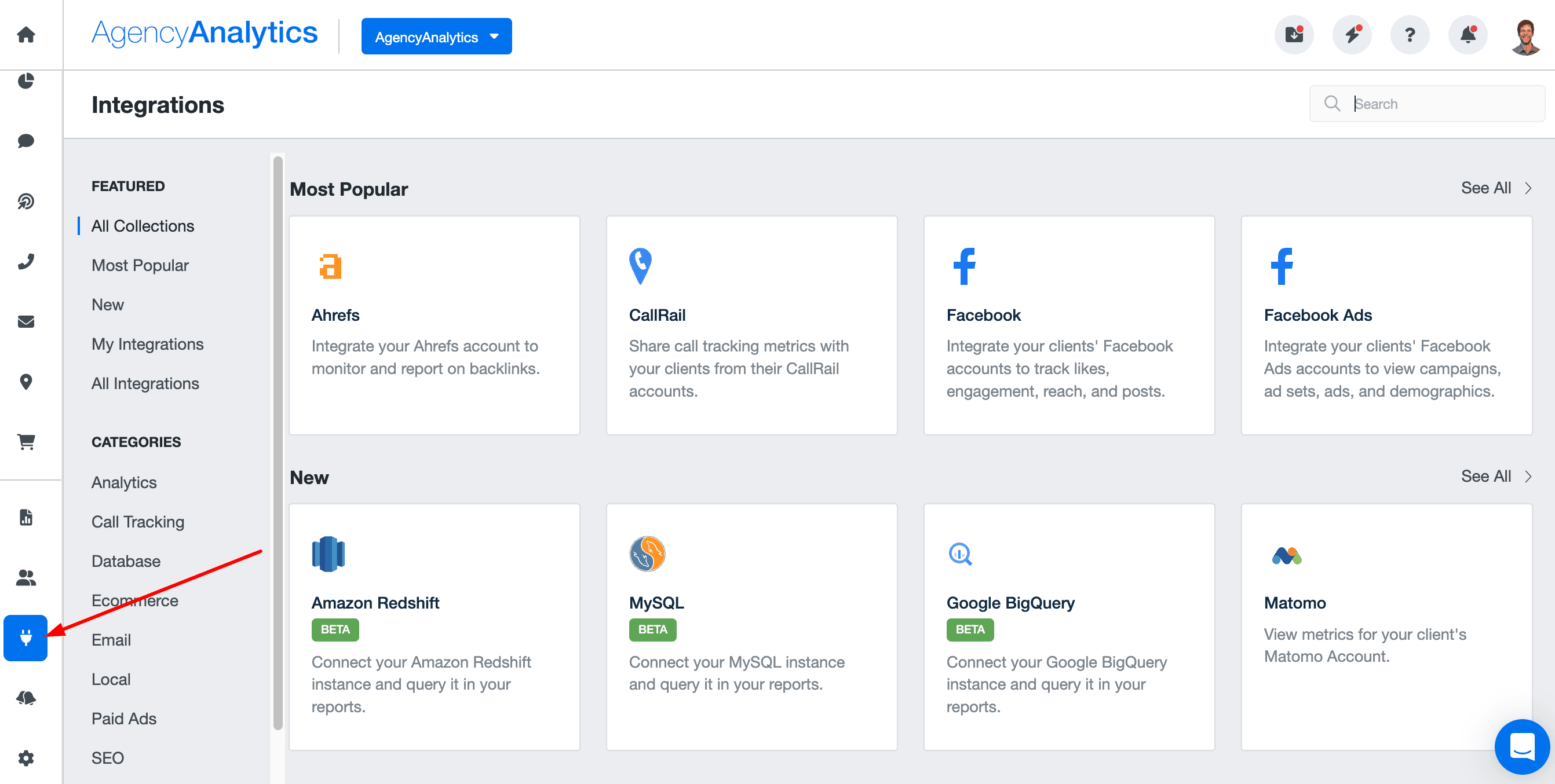
Then, click on your desired platform and follow the on-screen instructions to successfully connect your client’s integration.
Use a Pre-Built Template or Create Your Own Dashboard
Now that the initial setup is done, it’s time to monitor real-time backlink insights. Simply:
Stream data into a platform-specific template (e.g., an Ahrefs dashboard) for detailed, actionable insights. Monitor new vs. lost backlinks, Domain Authority, backlink acquisition trends, and more!
Use a general SEO dashboard to view related insights across multiple platforms.
Build a custom dashboard by using the drag-and-drop editor.
Create a Smart Dashboard that automatically populates with your client’s unique metrics. It’s fully customizable, too!
The best part? It’s easy to flip any AgencyAnalytics dashboard into a report. Generate a downloadable PDF, create a shareable link, or even send an email–it’s all up to you.
Ask AI for Instant Backlink Insights
Backlink tracking doesn’t have to be time-consuming. Use Ask AI to instantly generate clear, data-driven insights about your client’s backlink performance.
It’s as simple as using a pre-defined prompt or asking a custom question! Use this feature to:
Monitor Backlink Trends: Track how your client’s backlink profile evolves over time–identify growth patterns, lost links, and new acquisition opportunities.
Form Not-So-Obvious Relationships Between Metrics: Uncover hidden connections between backlinks, domain authority, search rankings, and other SEO insights.
Create a Text-Based Performance Overview: Instead of spending hours analyzing campaign data, use AI Summary to generate concise, easy-to-understand takeaways.
By integrating Ask AI into your workflow, you’ll quickly extract meaningful insights and deliver clearer results—all in a fraction of the time.
Invest in a Robust System to Monitor and Optimize Backlink Efforts
As we’ve covered, competitor link analysis isn’t just about acquiring more backlinks. It’s an ongoing process that helps clients stay ahead of competitors, improve rankings, and achieve long-term SEO results.
To recap:
Use an SEO Tool to Automate Backlink Insights: Leverage platforms like Ahrefs, Semrush, Moz, or Majestic to track backlink trends, monitor competitor activity, and uncover valuable opportunities.
Analyze Competitor Strategies for Untapped Link Opportunities: Identify which backlinks drive the most impact for competitors and look for gaps your client can fill. This could mean targeting the same high-authority sites or pursuing untapped opportunities.
Prioritize Backlinks From Relevant Websites: Not all backlinks are equal. Focus on Tier 1 and Tier 2 backlinks—high-authority, niche-relevant links that move the needle for rankings. Target Tier 3 links (sparingly) for diversification.
Consolidate SEO Insights Into a Central Hub: Instead of juggling data across multiple platforms, integrate backlink insights into a single dashboard with a tool like AgencyAnalytics.
Whether you’re focused on SEO or a range of marketing services, use AgencyAnalytics to take the hassle out of reporting. Automatically retrieve data from 80+ platforms and counting–sign up for a free 14-day trial today.

Written by
Faryal Khan is a multidisciplinary creative with 10+ years of experience in marketing and communications. Drawing on her background in statistics and psychology, she fuses storytelling with data to craft narratives that both inform and inspire.
Read more posts by Faryal KhanSee how 7,000+ marketing agencies help clients win
Free 14-day trial. No credit card required.


